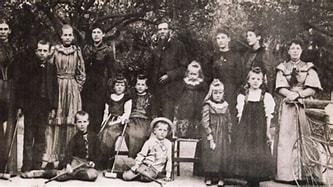The Hidden History of Polygamy in America
Introduction
When we think of marriage in America, the image that often comes to mind is that of a man and a woman walking down the aisle, exchanging vows in front of family and friends. However, the reality is much more complex. Polygamy—marriage to multiple partners—has a rich and varied history in the United States that many people are unaware of. From early indigenous practices to the infamous Mormon settlements, polygamy has played a significant role in shaping American society. So, what’s the story behind this often-hidden aspect of our marital history? Let’s dive into the fascinating world of polygamy in America!
What is Polygamy?
Defining Polygamy
Polygamy refers to the practice of having more than one spouse at the same time. While many people associate polygamy primarily with polygyny (one man having multiple wives), it also includes polyandry (one woman having multiple husbands) and group marriages involving multiple spouses of both genders.
Cultural Context
Polygamy has existed in various forms across cultures and historical periods. In many societies, it was seen as a way to increase family lineage or consolidate wealth and power. In contrast, Western cultures have predominantly favored monogamous relationships, often viewing polygamy as outdated or morally questionable.

The Early History of Polygamy in America
Indigenous Practices
Long before European settlers arrived, various indigenous tribes practiced polygamy. For instance, many Plains Indian tribes allowed men to have multiple wives as a sign of wealth and status. This practice was not merely about personal desire; it also served economic and social functions within these communities.
Colonial Influences
When European settlers arrived in North America, they brought their own views on marriage with them. However, some colonial groups, particularly those influenced by religious beliefs or economic needs, embraced polygamous arrangements. For example, certain Puritan communities practiced plural marriage as a solution to gender imbalances caused by high male mortality rates.
The Rise of Mormon Polygamy
Joseph Smith and Early Revelations
One of the most well-known instances of polygamy in American history is its association with The Church of Jesus Christ of Latter-day Saints (LDS Church). In 1843, Joseph Smith claimed to receive a revelation from God endorsing plural marriage. This revelation led to the practice becoming a significant aspect of early Mormon life.
Brigham Young’s Influence
After Smith’s death, Brigham Young became the second president of the LDS Church and openly practiced polygamy himself. Young had over 50 wives and believed that plural marriage was essential for achieving higher levels of spirituality and salvation.
Legal Challenges and Social Backlash

The Morrill Act of 1862
As polygamous practices became more widely known, they faced increasing scrutiny from the U.S. government. The Morrill Act of 1862 sought to prohibit plural marriage in U.S. territories. While enforcement was lax initially due to the Civil War, this marked the beginning of legal challenges against polygamy.
The Edmunds Act and Beyond
In 1882, Congress passed the Edmunds Act, which further criminalized polygamous practices and disenfranchised those who engaged in them. This law reflected growing public sentiment against polygamy, which many viewed as an affront to traditional American values.
The Decline of Polygamous Practices
The Manifesto of 1890
Facing intense pressure from the federal government, LDS Church President Wilford Woodruff issued a manifesto in 1890 officially renouncing polygamous practices within the church. This marked a turning point for Mormons as they sought acceptance into mainstream American society.
Continued Resistance
Despite the church’s official stance against new plural marriages, some fundamentalist groups continued to practice polygamy in secret. These groups believed that they were upholding divine commandments against societal pressures.
Contemporary Polygamous Communities
Modern Fundamentalist Groups
Today, there are still communities practicing polygamy in America, primarily among fundamentalist Mormons who have broken away from the mainstream LDS Church. These groups often live in isolated areas like Colorado City in Arizona or Hilldale in Utah.
Legal Status Today
While polygamy remains illegal across the United States, enforcement varies significantly by state. Some states focus on prosecuting related crimes like child abuse or welfare fraud rather than targeting consensual adult relationships.
The Cultural Impact of Polygamy
Media Representations
Polygamy has captured public interest through various media representations—think reality TV shows like “Sister Wives” or documentaries exploring fundamentalist communities. These portrayals often spark debates about morality and ethics surrounding non-traditional relationships.
Feminist Perspectives
The feminist movement has also weighed in on discussions about polygamy. Some argue that it can empower women by providing them with support networks and shared resources; others contend that it perpetuates patriarchal structures that can lead to oppression.
The Ethical Debate Surrounding Polygamy
Autonomy vs. Exploitation
At its core, the debate over polygamy often centers on issues of autonomy versus exploitation. Advocates argue for personal choice and freedom in relationships; critics warn against potential abuses within these arrangements.
Societal Norms and Values
The acceptance or rejection of polygamous relationships can reflect broader societal norms and values regarding family structures, gender roles, and individual rights. As society evolves, so too do perceptions about what constitutes a valid family unit.
Lessons from History: What Can We Learn?

Understanding Diversity in Relationships
The history of polygamy teaches us about the diversity of human relationships throughout time. It challenges us to consider different cultural perspectives on love, commitment, and family dynamics.
Navigating Modern Relationships
As we navigate our own relationships today—whether monogamous or otherwise—it’s essential to remain open-minded about different arrangements that work for others while advocating for ethical practices within all relationship types.
Read This: How to Know the Best Cryptocurrency Exchanges for your Investment
Conclusion: Embracing Complexity
The hidden history of polygamy in America reveals a rich tapestry woven with cultural significance and social implications. From indigenous practices to modern fundamentalist communities, this complex subject challenges our understanding of marriage itself. As we continue to explore diverse forms of relationships today—whether through media representation or personal experiences—we must embrace complexity while advocating for ethical treatment within all forms of love.
Meta Description
Explore the hidden history of polygamy in America, uncovering its roots, cultural significance, and the evolution of marriage practices over time.
FAQs
- What is polygamy?
- Polygamy is the practice of having more than one spouse simultaneously; it includes forms like polygyny (one man with multiple wives) and polyandry (one woman with multiple husbands).
- What role did Mormons play in American polygamy?
- Mormons significantly influenced American polygamy through their early adoption of plural marriage based on revelations from church leaders like Joseph Smith and Brigham Young.
- Is polygamy legal in the United States?
- Polygamy is illegal throughout the U.S., but enforcement varies by state; some states focus on related crimes rather than consensual adult relationships.
- What are some modern examples of polygamous communities?
- Contemporary fundamentalist Mormon groups continue to practice polygamy mainly in isolated communities such as Colorado City (Arizona) and Hilldale (Utah).
- How has media representation affected perceptions of polygamy?
- Media portrayals—such as reality TV shows—have sparked public interest and debate surrounding non-traditional relationships while often framing them within moral or ethical discussions.

